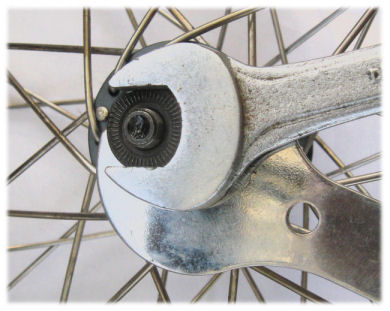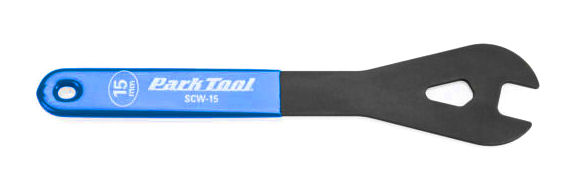Über Konusschlüssel: Unterschied zwischen den Versionen
(→Misshandlung vermeiden: übersetzt) |
(→Spiel reduzieren: ergänzung) |
||
| Zeile 56: | Zeile 56: | ||
At this point, there should be no noticeable play in the axle. if you cannot eliminate almost all of the play from the axle without causing the bearings to bind, the hub needs to be cleaned and repacked, possibly with some new parts. | At this point, there should be no noticeable play in the axle. if you cannot eliminate almost all of the play from the axle without causing the bearings to bind, the hub needs to be cleaned and repacked, possibly with some new parts. | ||
{{Ergänzung|Ergänzung durch [[John Allen]]| | |||
Some hubs with sealed cartridge bearings have double locknuts on each end. The axle generally has a flange inboard each bearing. The bearing's inner race is clamped between this flange at the inside and the inner locknut at the outside. The cartridges use radial-contact bearings: that is, the bearing balls ride in the bottom of rounded grooves in the inner and outer raceways, rather than on angled surfaces as in cup and cone bearings. | Some hubs with sealed cartridge bearings have double locknuts on each end. The axle generally has a flange inboard each bearing. The bearing's inner race is clamped between this flange at the inside and the inner locknut at the outside. The cartridges use radial-contact bearings: that is, the bearing balls ride in the bottom of rounded grooves in the inner and outer raceways, rather than on angled surfaces as in cup and cone bearings. | ||
| Zeile 61: | Zeile 62: | ||
Despite the locknuts, this kind of hub is non-adjustable. It should turn freely, and if installed in a wheel, there should be a very slight amount of play at the rim. If it binds, that is probably because the bearing balls are riding on the side of the raceway. This can occur if the cartridge is not properly seated due to dirt or burrs, or if the axle is not exactly right for the hub. | Despite the locknuts, this kind of hub is non-adjustable. It should turn freely, and if installed in a wheel, there should be a very slight amount of play at the rim. If it binds, that is probably because the bearing balls are riding on the side of the raceway. This can occur if the cartridge is not properly seated due to dirt or burrs, or if the axle is not exactly right for the hub. | ||
}} | |||
==Die Achse komprimieren== | ==Die Achse komprimieren== | ||
Version vom 19. Oktober 2021, 09:29 Uhr
Obsolet sind die Inhalte dieses Artikels also nicht. Man findet immer noch Konen am Fahrrad, die man mit einem Konusschlüssel einstellen kann.
Manche Fahrrad-Spezialwerkzeuge sind Zeit- und Arbeitserleichterungen für Tätigkeiten, die man auch mit Standardwerkzeugen durchführen könnte; manche Spezialwerkzeuge sind absolz notwendig für bestimmte Tätigkeiten. Unter diesen essenziellen Werkzeugen sind Konusschlüssel. Man kann sie durch kein Standardwerkzeug ersetzen.
Konusschlüssel ähneln normalen offenen zweiseitigen Maulschlüsseln. Sind siend nur wesentlich dünner. Ein typischer qualitativ hochwertiger 14 mm Maulschlüssel (oder Engländer) ist ungefähr sieben Millimeter dick (0,28 Zoll); billige Schlüssel sind sogar noch dicker. Konusschlüssel sind jedoch etwa zwei Millimeter (0,08 Zoll) dick.
In den meisten Fällen kann ein Standardmaulschlüssel oder ein verstellbarer Rollgabelschlüssel für die Kontermutter des Konus genommen werden. Der Konus selbst kann jedoch nur mit einem Konusschlüssel eingestellt werden, weil die flachen Seiten sehr schmal sind und man nicht viel Platz hat.
Die Kontermutter eines Konus mit zwei Schlüssel anziehen
Konusschlüssel werden üblicherweise in den Größen 13/14 Millimeter, 15/16 Millimeter und 17/18 Millimeter ausgeliefert. Wenn man die Wartung von Nabenkonen selbst durchfühhren möchte, muss man mindestens einen Schlüssel in der notwendigen Größe zu hause haben. Der beste Weg, herauszufinden, ob der Konusschlüssel, den man kaufen möchte, passt, ist der Weg zum Fahrradgeschäft und vor Ort den Schlüssel ausprobieren.
Billige Werkzeuge sind niemals ein gutes Geschäft. das gilt auch insbesondere für Konusschlüssel. Wegen ihre extremen Flachheit und der Größe der Muttern, auf die sie passen, müssen Konusschlüssel aus besonders hochqualitativem Stahl gefertigt sein, damit sie die Kräfte, die im Gebrauch aufgewendet werden, aushalten. Schlechte Konusschlüssel verbiegen sich direkt bei der ersten Nutzung und werden damit nutzlos.
Campagnoloqualität
Wie bei so vielen anderen Fahrradwerkzeugen und -bauteilen ist Campagnolo der Standard, den man für Vergleiche heranzieht. Sheldon Brown hat seine Campagnolo Konusschlüssel bereits zwölf oder dreizehn Jahre (vermutlich also seit Anfang der 1970er Jahre) im Einsatz und sie sind noch genauso passgenau wie am ersten Tag. Er hat die Campagnolo Konusschlüssel angeschafft, nachdem er mehrere billige französische Konusschlüssel im professionellen Einsatz innehralb kürzester Zeit verschlissen hatte. Bis dahin hat er Nichts gefunden, das bei ernsthaftem Einsatz lange hielt.
In den letzten Jahren (Anfang der 1980er Jahre!) sind jedoch aus Amerikanischer und Japanischer Produktion brauchbare Konusschlüssel zu einem vernünftigen Preis auf den Markt gekommen. Im Allgemeinen bekommt man qualitativ hochwertigere Werkzeuge, wenn man sie einzeln kauft statt vorkonfektionierter "Fahrrad Werkzeugkoffer".
Schwinn stellt besonders gute Konusschlüssel für den Werkstatteinsatz her. Sie haben nur ein Werkzeugende und haben einen komfortablen Kunststoffüberzug am Griff. Unglücklicherweise muss man, weil sie Einender sind, insgesamt zehn Stück kaufen, damit man für jede der fünf gängigen Größen zwei Stück zur Hand hat. 18 mm Konusschlüssel scheinen so selten zu sein, dass selbst Sheldon diese Größe nie im Einsatz hatte.
Die obige Markenempfehelung ist nicht mehr ganz aktuell. Inzwischen ist das bevorzugte Werkezug ein Lasergeschnittenes Park Tool SCW-15 mit schwarzem Finish für Werkstätten.
Es gibt Zeiten, zu denen zwei Konusschlüssel der gleichen Größe essenziell sind. So benötigen zum Beispiel Campagnolo Record Hinterradnaben zwei 14 mm Schlüssel für beide Konen und die Kontermutter; die Kontermuttern haben schmale Flachstellen und verjüngen sich so stark, dass man auch bei der Kontermutter wie beim Konus nur mit einem Konusschlüssel ordentlich arbeiten kann.
Schneller mit Zweien
Even when two identical cone wrenches are not essential, they are a great aid in adjusting the cones quickly and exactly.
If you do not have two of each needed size, to make even the smallest change in the cone adjustment, you must first loosen the locknut, then adjust the cone, then re tighten the locknut. If you get the cone adjustment just right but the locknut is not sufficiently tight, tightening the locknut will throw the cone adjustment off. Careful cone adjustment by this technique is a very time-consuming process of trial and error.
If you have two wrenches of each needed size, the fine adjustment can be done much more quickly and easily! First, get the cones in roughly correct adjustment, with the locknuts fairly tight. Now, if the cone adjustment is too tight, put a wrench on each cone and back the cones away from each other.
This will simultaneously loosen the cone adjustment and further tighten the locknuts. If the cone adjustment is a bit too loose, put a wrench on each locknut and tighten them together. This will tighten both the cone adjustment and the locknuts at the same time. This approach will enable you to make very small adjustments to the cones without loosening the locknuts.
There is a supposedly non-rotating washer between each cone and locknut, which you might think would keep this system from working, but it does not in practice, as long as you start with a reasonably good rough adjustment.
Spiel reduzieren
The correct adjustment for solid-axle hubs is to get the cones tight enough to reduce play to a minimum without causing the axle to bind when turned. You should first judge the freeness of the bearing when the cones are too loose, so that there is a little bit of play.
Pretend that you are a safecracker and that the axle is the knob of a safe. Hold the axle by a cone locknut very gently with your fingertips. Revolve the axle slowly several revolutions. Do this by turning your wrist, not by rolling the axle in your fingers. You should feel almost no resistance, and no unevenness in the rotation.
If there is roughness or unevenness with the bearings adjusted loose, it means that your bearing surfaces are damaged, your axle is bent, or there is foreign matter (dirt) in the bearings.
If it turns smoothly and without resistance with the cones loose, remember how that feels. Tighten the cones bit by bit until you feel slightly increased resistance, then back the adjustment off just enough to get rid of the resistance.
At this point, there should be no noticeable play in the axle. if you cannot eliminate almost all of the play from the axle without causing the bearings to bind, the hub needs to be cleaned and repacked, possibly with some new parts.
Some hubs with sealed cartridge bearings have double locknuts on each end. The axle generally has a flange inboard each bearing. The bearing's inner race is clamped between this flange at the inside and the inner locknut at the outside. The cartridges use radial-contact bearings: that is, the bearing balls ride in the bottom of rounded grooves in the inner and outer raceways, rather than on angled surfaces as in cup and cone bearings.
(How do they get the bearing balls in, you may ask? By placing the races eccentrically from one another, so there is a big space on one side -- introducing bearing balls only on that side, and then spacing the bearing balls evenly and snapping a retainer into place to hold them in position. )
Despite the locknuts, this kind of hub is non-adjustable. It should turn freely, and if installed in a wheel, there should be a very slight amount of play at the rim. If it binds, that is probably because the bearing balls are riding on the side of the raceway. This can occur if the cartridge is not properly seated due to dirt or burrs, or if the axle is not exactly right for the hub.
Die Achse komprimieren
If you have quick-release hubs, this is just the starting point. When the quick-release skewer is tightened, it slightly compresses the axle, making the cone adjustment tighten. If your cones are perfectly adjusted with the skewer loose, they will become too tight once the wheel is installed and the quick release is tightened.
To compensate for this, cones on quick-release hubs must be adjusted so that there is a little bit of play when they are not on the bicycle. The very final tightening is done with the quick-release skewer When the cones are properly adjusted on a quick-release wheel, there should be slight bearing play if the quick-release skewer is only partially tightened. This play should just disappear once the quick-release is fully tightened. My article on cone adjustment describes a special tool that compresses the axle, avoiding the need for trial-and-error adjustment.
Axle compression is a particular problem with some cartridge-bearing hubs, because these are non-adjustable. The better cartridge-bearing hubs have an extra-rigid large-diameter axle.
Missbrauch vermeiden
Weil Konusschlüssel in allgemeinüblich nützlichen Größen daherkommen und sehr leicht sind, ist es oft verführerisch, sie zu anderen Zwecken einzusetzen. So kann man sie zum Beispiel zur Satteljustage, zum Befestigen von Achsenmuttern oder für Pedalachsen benutzen. Widerstehe dieser Versuchung! Diese Werkzeuge sind nur für Konen und jeder andere Einsatzzweck stellt einen Missbrauch dieses feinen Werkzeugs dar. Jeder andere Einsatzzweck benötigt deutlich mehr Drehmoment als Einstellarbeiten an Konen. Diese dünnen Werkzeuge sind für so harten Einsatz nicht gemacht. Hochqualitative Werkzeuge sollten ein Leben lang halten, wenn sie vernünftig behandelt werden.
Quelle
Dieser Artikel basiert auf dem Artikel Tool Tips Cone Wrenches von der Website Sheldon Browns. Originalautor des Artikels ist Sheldon Brown.
- Sattelstützenmaße
- Knarzen, Knacken und Quietschen
- Ritzelabstände (Tabelle)
- Auswechselbarkeit von Vierkant-Kurbelaufnahmesystemen bei Innenlagern
- Kettenlinienstandards (Tabelle)
- Ein bequemer Sattel
- Nabenbreiten (Tabelle)
- Alles über Nabenschaltungen
- Shimano Nexus und Alfine Acht-Gang-Naben
- Reifengrößen


